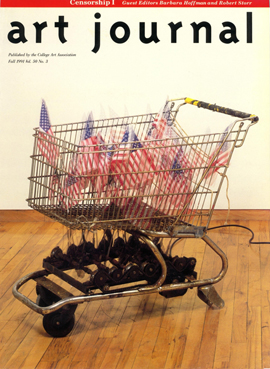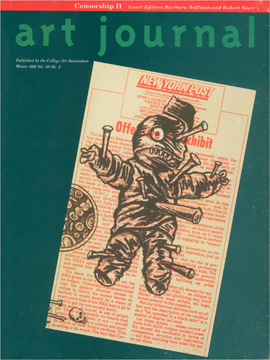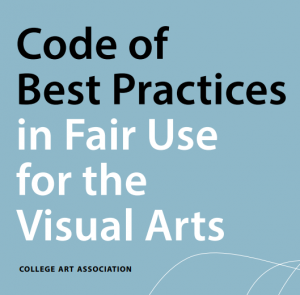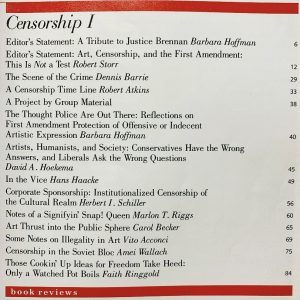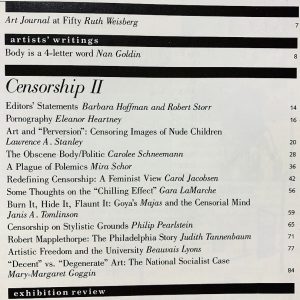CAA News Today
Member Spotlight: Barbara Hoffman
posted by CAA — November 21, 2019
Up next in our Member Spotlight series, we are highlighting the work of Barbara Hoffman, founder and principal of The Hoffman Law Firm and a pioneer in the field of art law who served as CAA’s pro bono legal counsel for ten years. Joelle Te Paske, CAA’s media and content manager, spoke with Barbara over the phone to learn about her rich history with CAA. Read the interview, edited for length and clarity, below.

Image courtesy Barbara Hoffman.
Hi Barbara. I’m delighted to have the chance to speak with you. You are one of our esteemed lifetime members who has been a part of the organization in various capacities for more than 40 years. That’s incredible.
The pleasure is mine. I loved working with CAA during my tenure there.
Just looking over your bio on your website, I’m just amazed at how many different roles you’ve taken on over your career as an art lawyer. How did you first get involved with CAA?
I’ve always been interested in art, and I studied in Paris at the Académie Julian during my junior year when I majored in French and Art History. But I wasn’t very aware of the College Art Association.
After my studies, I was one of the early art lawyers. I had founded the Volunteer Lawyers for the Arts in the state of Washington, and continued to develop and write on the subject of art law, at a time when there were only a handful of people who were doing it.
Before then, I practiced civil rights law in New York. I’m from New York—I went to Columbia Law School—and was helping artists on the side when I was in my senior year. I volunteered as a lawyer for the first Volunteer Lawyers for the Arts in New York. I was then recruited to be a law professor in Seattle and I’d had so much fun with Volunteer Lawyers for the Arts that I thought I would join the Washington branch when I moved. When it didn’t exist, I ended up founding the statewide Washington Volunteer Lawyers for the Arts, and hosting an art law clinic at the law school.
Oh, interesting. So it started in New York and then you brought it over to the West Coast, in Washington.
Yes. Then eventually I moved back to New York and I joined the New York City Bar Art Law Committee. I was also Chair of the Public Art Subcommittee. We drafted a balanced, annotated model contract to be made available to artists and administrators. Percent for Art was just starting, and most artists and bureaucrats had little knowledge of copyright and other issues in public art.
The National Endowment for the Arts put together a task force of artists and administrators in which I was invited to participate, alongside Joyce Kozloff, who was on the CAA Board of Directors at the time. Susan Ball was executive director at the time. There was a feminist uprising, and my name was put forward to replace Gil Edelson.
I was CAA’s pro bono outside counsel and member of the executive committee for ten years. Among many activities, I wrote a column for CAA on legal issues. My fondest memories are those of working with the different CAA committees and their chairs. Particularly memorable was the work I did with Albert E. Elsen, a professor of art history and a great scholar on Rodin. We revised the guidelines for the code of ethics for art historians. And I worked with several well-known artists too, many of whom are no longer with us.
I also advised all the CAA publications. This was an interesting time for the issues of fair use and copyright in images. Through me, CAA got involved in what was called the Conference on Fair Use, taking place under the US Patent and Trademark Office and the US Copyright Office, which dealt with bringing copyright law into the digital world.
Before I came in to represent CAA, most of the people there were representing either libraries on one side, who were of course for fair use, or publishers, both trade book and academic publishers, who were of course for a stricter interpretation and enhanced copyright protection. But nobody was really talking about issues like images until we brought up to the subject.
On that issue I worked very hard, and CAA worked very hard. It was extremely controversial for the organization, because as you know, everybody at CAA wears multiple hats and the copyright issues involved both publishers and scholars. So I worked with the Copyright Committee and Fair Use and Christine L. Sundt, president of the Visual Resources Association and a member of CAA. She was a passionate devotee of legal issues there.
I imagine those are the fundamental building blocks for CAA’s Code of Best Practices in Fair Use that was published in 2015.
There are earlier versions of it, too. There was one during my tenure and then it evolved over time. We were never successful in terms of getting the government, the Conference on Fair Use, to be able to come together to develop official guidelines. I spent hours and hours and hours developing scenarios. We tried to get people’s agreement on the analysis and whether it was or wasn’t fair use. But at the end there was never a resolution of that and I think it continued on until 2015. It was a long-going effort. We were the first people to really address the whole issue in the late eighties, early nineties.
That’s fascinating. And especially now, with the emergence of the internet.
Another thing that we were really involved with during my tenure was the issue of freedom of expression. I represented CAA and was active in what we now call the Culture Wars, when Jesse Helms tried to ban the publication of [Robert] Mapplethorpe’s images. This was in 1989, and continued through the 1990s.
They were extremely active times. I’m most proud of the two-volume issue I did on censorship with Robert Storr for Art Journal. It was voted at the hundredth anniversary conference the best Art Journal that was published in the journal’s history.
To accompany this interview, we’ve brought the historic two-volume issue out from behind the paywall for readers to explore through the end of December 2019: Censorship I and Censorship II
For the double issue, I dedicated my statement to Justice Brennan of the Supreme Court. In my view, his decisions on the Supreme Court regarding the First Amendment and freedom of expression basically did more to provide contours of protection for artistic expression than any other Supreme Court Justice.
Then Rob Storr made his editor’s statement a full reprint of Mapplethorpe’s X Portfolio. He got permission from the Mapplethorpe Foundation because of his connections to publish them, but when we sent it to our normal printer, they were afraid to publish it because they thought they (or CAA) would be sued for pornography. They asked us to find a different printer. So we sent it around to all these places that might publish pornography. But the pornography magazines that we sent them to didn’t have the quality that we would require for the CAA journals! So we went to The Burlington Magazine and asked them if they would print it. It was much more expensive, but our usual printer paid the difference. So it was actually printed, by my recollection, by The Burlington Magazine.
There were two fall outs from the issue. The first fall out was a number of CAA members dropped their membership. Pretty amazing. They said the issue should have come with a warning label. You know, they got it in the mail, they left it on the table, and then their children saw it, with no warning.
Another spin off was because the CAA journal goes to every single university that’s a member for the library and art departments, the images that people had been talking about—but never saw—were suddenly available. As part of this I ended up participating in a panel at the University of Nashville, defending a professor who had brought that issue to his class of drawing and photography.
It was all a very meaningful experience. As a result, I was involved in authoring two friends of the court briefs, in the district court and the appellate court, on behalf of the College Art Association. Those were then quoted by the court defending Karen Finley and what they called the NEA Four [Karen Finley, Tim Miller, John Fleck, and Holly Hughes], who had their NEA grants declined because of the Helms amendment. So we introduced a friend of the court brief on behalf of College Art Association, and another one was on behalf of College Art Association and PEN America.
Later on, the organization’s centennial publication featured an image from Faith Ringgold’s French series that I licensed as her lawyer at the time. Faith was an active CAA member on the board and committee on diversity.
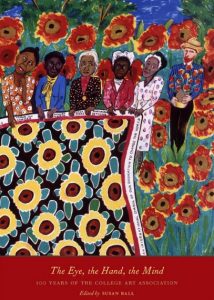
CAA’s centennial publication,The Eye, The Hand, the Mind: 100 Years of the College Art Association, with Faith Ringgold’s The Sunflower Quilting Bee at Arles (1996) on the cover.
The complexity of being an art lawyer—it brings you into so many different issues.
It was great. As I said, I worked with all the CAA Committees over that time. I still go to conferences from time to time and participate. And I just, you know, I’m happy to see so many artists that I’ve worked with being rewarded over time by the CAA. I’ve shown up for their presentations, the last ones being Howardena Pindell and Ursula von Rydingsvard for lifetime achievements.
Yes! Our 2019 honorees.
So I’m still keeping up and seeing how the organization has grown and changed. My legacy is these cases, my friends, and the guidelines. A wonderful opportunity for me to combine my passions—law and art history. As a member of the Executive Committee I attended all the CAA annual conferences, and when I wasn’t doing official business, I’d go to art history sessions. I have very happy memories of the wonderful people that I met there. I’m still in contact with many of them. That’s a part of my life that’s ongoing.
That’s wonderful.
And I’m still doing the same thing—still fighting for artists. Still fighting for the first amendment. Still doing public art. So, I feel very fortunate to be a life member.
Barbara Hoffman Biography
The Hoffman Law Firm continues as a preeminent global art and copyright boutique with a focus on Europe, Asia, Africa, and the United States. Author and editor of A Visual Artist’s Guide to Estate Planning (1996 and 2008), Barbara Hoffman also advises artists, galleries, and their estates on legacy planning, and endowed foundations.
Barbara has been recognized by her peers and clients with leadership posts and honor, including as Chair of the New York City Bar Association Committee on Art Law, Chair of the International Bar Association Committee on Art and Cultural Institutions and Heritage Law, and being selected to New York Super Lawyers, Best Lawyers in America, and Best Law Firms in art law and copyright law (2012-2020).
In addition to her service on the CAA executive committee, Barbara serves or has served on many boards, including ArtTable, Performa and the boards of several artists’ foundations. She was voted one of Art and Auction 51’s Power Women in the Art World 2016. www.hoffmanlaw.org
Deadline extended! Annual Conference Committee Seeks Members
posted by CAA — November 12, 2019
CAA invites nominations and self-nominations for two at-large members of the Annual Conference Committee to serve a three-year term. Terms begin February 2020, immediately following the 108th Annual Conference.
The Annual Conference Committee, working with the CAA Programs Department, selects the sessions and shapes the program of the Annual Conference. The committee ensures that the program reflects CAA’s goals for the conference, namely, to make it an effective place for intellectual, aesthetic, and professional learning and exchange; to reflect the diverse interests of the membership; and to provide opportunities for participation that are fair, equal, and balanced.
The Annual Conference Committee meets during the conference and at the call of the program chair and vice president for Annual Conference. Committee members also serve to support sessions comprised of individual papers and projects where a formal chair has not been identified.
Please send a 150-word letter of interest and a CV to Mira Friedlaender (mfriedlaender@collegeart.org), CAA manager of annual conference.
Deadline (extended): February 18, 2020
Announcing New CAA Professional Committees
posted by CAA — August 08, 2019
CAA is pleased to announce the creation of two new professional committees: a Committee on Research and Scholarship, and a Services to Historians of Visual Arts Committee. The new committees were approved by the Board of Directors at their May 2019 meeting. Concurrent with our annual call for new committee members, we seek applicants to form the inaugural teams for these two new committees.
The deadline for these applications is October 1, 2019, for new committee service to begin at the Annual Conference in February 2020.

Discussion group at 2018 CAA Annual Conference. Photo: Rafael Cardenas
The formation of these new committees responds to requests from our membership and to a desire to be forward-looking in addressing the professional needs of our fields.
The Committee on Research and Scholarship will offer a resource to all members engaged in the production or consumption of scholarly research.
The Services to Historians of Visual Arts Committee will identify and address concerns facing the historian members of our organization (encompassing specialists in any facets of art, architecture, design, material culture, and visual culture).
The Services to Historians of Visual Arts Committee is intended to recognize our organization’s enduring support for historians, offering them a presence and a voice similar to the role played by other profession-specific committees in our organization (such as the Services to Artists Committee and the Committee on Design). As noted in the committee charge, the Services to Historians of Visual Arts Committee “offers a forum for the discussion of issues of mutual interest across the discipline’s many diverse fields and methodologies. In a climate of great threat to the survival of history of art and history of visual arts programs, this committee provides a locus for advocacy issues particular to historians in these areas of interest.” It is understood that the committee will play an active role in the Annual Conference but is also intended to serve as a central hub and resource for communication among historians of the visual arts well beyond the chronology of conference programming.
As stated in the committee charge, the Committee on Research and Scholarship is charged with “gathering information, [and] assessing and proposing organizational advocacy for CAA on matters concerning the research and scholarship in visual arts and design, encompassing all facets of research regarding history, theory, education and practice.” Specialists in the visual arts—whether practitioners or historians—face unique challenges in the production of their scholarship, such as the cost of image permissions, the closures or reorganization of academic presses, and/or the misalignment of the multiyear workflow of exhibitions or excavations against the strictures of a tenure clock. A scholar’s type of institutional affiliation, or independent scholar status, has an enduring impact on the types of research and scholarship that can be produced—arguably in more profound ways than in other humanities or arts fields. The Committee on Research and Scholarship will provide a vital hub to our members interested in addressing any of these areas of concern—or advancing other concerns or questions concerning the area of research and scholarship.
If you wish to apply for either of these new committees, send an email to Vanessa Jalet at vjalet@collegeart.org with a brief statement of interest and attach a reduced résumé (no more than 2-3 pages).
Kindly also enter in the subject line: “Applicant for Committee on Research and Scholarship” or “Applicant for Services to Historians of Visual Arts Committee”
Deadline: October 1, 2019
Committee on Research and Scholarship Charge
The Committee on Research and Scholarship is charged with gathering information, assessing trends, and proposing organizational advocacy for CAA on matters concerning the advancement of research and scholarship in visual arts and design, encompassing all facets of research regarding history, education, and practice. Recognizing that professionals must navigate a rapidly-transforming field of options for conducting research and disseminating the results thereof, the committee is responsible for assisting the organization in engaging with current issues and serving its membership in this important facet of their professional life.
Services to Historians of Visual Arts Committee Charge
The Services to Historians of Visual Arts Committee identifies and addresses concerns facing historians of art, architecture, design, material culture, and visual culture. It creates and implements programs and events at the conference and beyond. It offers a forum for the discussion of issues of mutual interest across the discipline’s many diverse fields and methodologies. In a climate of great threat to the survival of history of art and history of visual arts programs, this committee provides a locus for advocacy issues particular to historians in these areas of interest. The Committee lends support and mentorship for both seasoned and emerging professionals. It is also charged with maintaining dialogue with other professional organizations and affiliated societies focused on the history of art, architecture, design, material culture and visual culture.
Serve on Professional Development Fellowship Juries
posted by CAA — April 22, 2019
CAA invites nominations and self-nominations for individuals to serve on our Professional Development Fellowship juries for three years (2019–22). Terms begin July 2019.
JURY VACANCIES FOR SPRING 2019
- Professional Development Fellowship in Visual Art: two members
- Professional Development Fellowship in Art History: one member
Duties and Qualifications
The fellowship juries award $10,000 each to one visual artist completing an MFA and one art historian completing a PhD in the coming year. Candidates for the art history jury must be actively publishing scholars with demonstrated seniority and achievement; candidates for the visual arts jury must be actively producing artists with a track record of exhibitions. Institutional affiliation is not required. Jury members review applications once per year and confer by conference call.
Candidates must possess expertise appropriate to the jury’s work and be current CAA members. They should not hold a position on a CAA committee or editorial board beyond May 31, 2019. CAA’s president and vice president for committees appoint jury members for service.
HOW TO APPLY
Nominations and self-nominations should include a brief statement (no more than 150 words) outlining the individual’s qualifications and experience and a CV (an abbreviated CV no more than two pages may be submitted). Please send all materials by email to Cali Buckley, CAA grants and special programs manager; submissions must be sent as Microsoft Word or Adobe PDF attachments.
For questions about jury service and responsibilities, contact Tiffany Dugan, CAA director of programs and publications.
Deadline: May 13, 2019
Serve on the Millard Meiss Publication Fund Jury
posted by CAA — April 19, 2019
CAA invites nominations and self-nominations for individuals to serve on our Millard Meiss Publication Fund jury for four years (2019–23). Terms begin July 2019.
JURY VACANCIES FOR SPRING 2019
- Millard Meiss Publication Fund: two members
Duties and Qualifications
The Millard Meiss Publication Fund jury awards subsidies to support the publication of book-length scholarly manuscripts in the history of art and related subjects. Members review manuscripts and grant applications twice a year and meet in New York in the spring and fall to select the awardees. CAA reimburses jury members for travel and lodging expenses in accordance with its travel policy. Members volunteer their services to CAA without compensation. Candidates must be actively publishing scholars with demonstrated seniority and achievement; institutional affiliation is not required.
Candidates must possess expertise appropriate to the jury’s work and be current CAA members. They should not hold a position on a CAA committee or editorial board beyond May 31, 2019. CAA’s president and vice president for committees appoint jury members for service.
HOW TO APPLY
Nominations and self-nominations should include a brief statement (no more than 150 words) outlining the individual’s qualifications and experience and a CV (an abbreviated CV no more than two pages may be submitted). Please send all materials by email to Cali Buckley, CAA grants and special programs manager; submissions must be sent as Microsoft Word or Adobe PDF attachments. For questions about jury service and responsibilities, contact Tiffany Dugan, CAA director of programs and publications.
Deadline: May 13, 2019
Serve on a CAA Award Jury
posted by CAA — March 28, 2019
CAA invites nominations and self-nominations for individuals to serve on ten of the fourteen juries for the annual Awards for Distinction for three years (2019–22). Terms begin in May 2019; award years are 2020–22.
CAA’s fourteen awards honor artists, art historians, authors, curators, critics, and teachers whose accomplishments transcend their individual disciplines and contribute to the profession as a whole and to the world at large.
Candidates must possess expertise appropriate to the jury’s work and be current CAA members. They should not hold a position on a CAA committee or editorial board beyond May 31, 2019. CAA’s president and vice president for committees appoint jury members for service.
Jury vacancies for spring 2019:
- The Art Journal Award: two members
- Alfred H. Barr Jr. Award: three members
- Frank Jewett Mather Award for Art Criticism: one member
- Charles Rufus Morey Book Award: two members
- Arthur Kingsley Porter Prize: two members
- CAA/AIC Award for Distinction in Scholarship and Conservation: one member
- Distinguished Artist Award for Lifetime Achievement: one member
- Distinguished Lifetime Achievement Award for Writing on Art: two members
- Distinguished Feminist Award: one member
- Distinguished Teaching of Art Award: one member
Nominations and self-nominations should include a brief statement (no more than 150 words) outlining the individual’s qualifications and experience and a CV (an abbreviated CV no more than two pages may be submitted). Please send all materials by email to Cali Buckley, CAA grants and special programs manager; submissions must be sent as Microsoft Word or Adobe PDF attachments. For questions about jury service and responsibilities, contact Tiffany Dugan, CAA director of programs and publications.
Deadline: May 13, 2019
Serve on a CAA Editorial Board, Committee, or Jury
posted by CAA — March 20, 2019
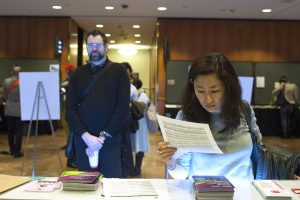
Attendees at the 2019 Annual Conference in New York. Photo: Ben Fractenberg
Each spring, members have the opportunity to provide critical service to the field and gain an inside view by volunteering to work on a CAA editorial board, committee, or jury.
Any member may self-nominate for the following positions or (after ascertaining interest) nominate another member. For more information, please click on the links below.
CURRENT OPPORTUNITIES
All deadlines for 2019 have passed.
CLOSED OPPORTUNITIES
Art Journal Open—Editor-in-Chief
Deadline: April 1
caa.reviews—Editor-in-Chief
Deadline: April 1
caa.reviews—Four Field Editors
Design History, Eighteenth-Century Art, Architecture and Urbanism, Theory and Historiography
Deadline: April 15
The Art Bulletin—Editorial Board Members
Deadline: April 15
Annual Conference—CAA Council of Readers
New this year, we’re asking members to serve a crucial role in shaping conference content.
Deadline: April 18
Annual Conference—Annual Conference Chair
Deadline: April 29
Annual Conference—Awards for Distinction Juries
Deadline: May 13
Millard Meiss Publication Fund—Jury Members
Deadline: May 13
Professional Development Fellowships in Art History and Visual Art—Jury Members
Deadline: May 13
Professional Committees—Seeking New Members
Committees: Design, Diversity Practices, Intellectual Property, Women in the Arts, Education, International, Museum, Professional Practices, Services to Artists, Student and Emerging Professionals
Deadline: September 18
Annual Conference Committee Seeks Next Chair
posted by CAA — March 15, 2019
CAA invites nominations and self-nominations for the Annual Conference Chair. This at-large member of the Annual Conference Committee serves a two-year term, beginning February 2020, immediately following the 108th Annual Conference. The Annual Conference Chair Designate shall begin their orientation to the role in May 2019. They will be invited to meetings of the Annual Conference Committee as a non-voting ex officio member at that time.
The Chair oversees the Council of Readers and reports back to the Annual Conference Committee on session topics, including identifying possible areas of content and interest to members that are missing from the submissions received. With CAA staff, the Chair recruits Council of Readers members to read, review, and rank proposals. The Chair shapes the content to the Annual Conference from the submissions as reported back by the Council.
Deadline: April 29, 2019
As a member of the Annual Conference Committee the Chair:
- Works with CAA staff and oversees the execution of the overall goals of the conference
- Ensures that the Annual Conference reflects the goals of the Association
- Makes the Annual Conference an effective place for intellectual, aesthetic, and professional learning and exchange
- Reflects the diverse interests of the membership
- Suggests conference content based on member interest
- Assists in scheduling the variety of chosen sessions, workshops, talks, etc.
- Proposes ways to increase conference participation and attendance
- Proposes new initiatives for the conference
- Proposes candidates for distinguished speakers
The Annual Conference Committee meets three times a year: February – in person at the Annual Conference to examine and discuss the operational aspects of the conference which recently concluded and ideas for the upcoming conference; May/June – on a conference call to review the recommendations by the Council of Readers for the upcoming Annual Conference; October – on a conference call to review final plans and any existing changes for the Annual Conference up to two years out.
Please send a 150-word letter of interest and a CV to Mira Friedlaender, CAA Manager of Annual Conference. Deadline: April 29, 2019.
Apply to Join the CAA Council of Readers
posted by CAA — March 12, 2019

Attendees at the 2019 Annual Conference in New York. Photo: Ben Fractenberg
Beginning this year, we are pleased to announce a new opportunity to help shape Annual Conference session content. In preparation for the 2020 Annual Conference in Chicago, the Annual Conference Committee will appoint a Council of Readers to read proposals submitted by CAA members and serve a crucial role in the review process.
The Council will be tasked with reading proposals with a focus on their specialty and will provide the knowledge and expertise of their fields to help shape the conference.
Pleas email Mira Friedlaender, Manager of Annual Conference, mfriedlaender@collegeart.org, or Tiffany Dugan, Director of Programs and Publications, tdugan@collegeart.org, with any questions.
The Art Bulletin Editorial Board Seeks New Members
posted by CAA — February 07, 2019
CAA invites nominations and self-nominations for two individuals to serve on the The Art Bulletin Editorial Board for a four-year term, July 1, 2019–June 30, 2023. The ideal candidate has published substantially in the field and may be an academic, museum-based, or independent scholar; institutional affiliation is not required. The Art Bulletin features leading scholarship in the English language in all aspects of art history as practiced in the academy, museums, and other institutions.
The editorial board advises The Art Bulletin editor-in-chief and assists by seeking authors, articles, and other content for the journal; performs peer review and recommends peer reviewers; may propose new initiatives for the journal; and may support fundraising efforts on the journal’s behalf. Members also assist the editor-in-chief to keep abreast of trends and issues in the field by attending and reporting on sessions at the CAA Annual Conference and other academic conferences, symposia, and events in their fields.
The Art Bulletin Editorial Board meets three times a year, with meetings in the spring and fall plus one at the CAA Annual Conference in February. The spring and fall meetings are currently held by teleconference, but at a later date CAA may reimburse members for travel and lodging expenses for New York meetings in accordance with its travel policy. Members pay travel and lodging expenses to attend the conference in February. Members of all editorial boards volunteer their services to CAA without compensation.
Candidates must be current CAA members in good standing and should not be serving on the editorial board of a competitive journal. Members may not publish their own work in the journal during the term of service. CAA encourages applications from colleagues who will contribute to the diversity of perspectives on The Art Bulletin Editorial Board and who will engage actively with conversations about the discipline’s engagements with differences of culture, religion, nationality, race, gender, sexuality, and access. Nominators should ascertain their nominee’s willingness to serve before submitting a name; self-nominations are also welcome. Please send a letter describing your interest in and qualifications for appointment, a CV, and your contact information to: Chair, The Art Bulletin Editorial Board, College Art Association, 50 Broadway, 21st floor, New York, NY 10004; or email the documents or inquiries to Joan Strasbaugh, CAA publications and program editor, at jstrasbaugh@collegeart.org.
Deadline: Monday, April 15, 2019



